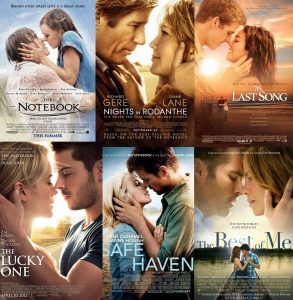
For this week’s posting, I will reexamine the Nicholas Sparks film posters and perform a metaphoric criticism.
The rhetor of these six films is a range of white actors and actresses or (more broadly) Nicholas Sparks, who wrote the film scripts and the novels that the films are based on. In my experience, the targeted audience is often straight white women who can identify with the relationships portrayed in the films. Each film emerges from a slightly different context, but the overarching context is one of contemporary heterosexual relationships in the southern United States. The posters each argue for the beauty of these relationships and, through the exclusion of other groups, seem to reject other types of love (between individuals of other races, the same sex, non-binary, etc.). The posters’ collective purpose is to promote the film franchise through the presentation of a similar and recognizable image.
The main metaphor expressed by these posters is that “two white heterosexuals gazing happily into each other’s eyes is love.” One could also infer a more implicit metaphor which states that “anything outside of these depictions of relationships is NOT love” given that each poster looks largely the same. In both cases, the portrayals of relationships would be the tenor and love would be the vehicle. The replicating nature of each poster creates a level of frequency which implies that repeatedly excluding other groups from these films is acceptable (and, perhaps, encouraged).